How to draw blood when you are dizzy with blood Why do some people get dizzy with blood

|
When we do some tests or physical examinations, we need to draw blood. This does not affect most people, but for a few people who are afraid of blood, drawing blood is a difficult problem to solve. So why do some people get afraid of blood? How do such people draw blood? How to draw blood when you faintFear of blood and fear of needles are actually common phenomena. Fear of blood is often manifested as dizziness, palpitations, nausea, cold sweats, pale complexion and cold limbs. First of all, it’s psychological factors. When patients see blood coming out, they feel fear and overly nervous. During the blood drawing process, they can distract themselves, not look directly, turn their heads away, take a deep breath, and try to relax themselves. Another factor is physical constitution. Blood drawing usually requires fasting. The doctor will inform you in advance. When you know you will have blood drawn, try to rest and don't overwork yourself. Prepare some sugar water before blood drawing and carry it with you. You can drink some after blood drawing. You can also watch some variety shows or something before having your blood drawn, which can help you relax and feel happy. Generally, having blood drawn is extremely stressful for patients who are afraid of blood. Being happy can help you relax, so it is recommended that you maintain a good attitude before having blood drawn. You can also find your own way to relieve stress according to your personal situation and relax yourself before having blood drawn. Why do some people faint when bleeding?The physiological mechanism of blood phobia: vasovagal syncope is caused by excessive stimulation of the vagus nerve, which leads to dilation of the body's blood vessels, slowing of the heart rate, and drop in blood pressure, resulting in blood accumulation in the lower limbs and reduced blood supply to the brain, causing the brain to stop working and loss of consciousness. Hemophobia is most common in children and young adults, with an estimated 3-4% of the population suffering from it. In addition to hemophobia, vasovagal syncope can also be caused by other factors, such as hunger, dehydration, standing up quickly, standing for too long, and severe coughing, all of which may trigger a vasovagal reaction. The symptoms of vasovagal syncope are completely opposite to those of fear. Fear causes blood pressure and heart rate to rise, and consciousness to become clear; whereas vasovagal syncope causes blood pressure to drop, which causes confusion and decreased consciousness. Therefore, fainting at the sight of blood is not a psychological fear. What to do if you have hemophobiaFainting is a classic symptom of vasovagal syncope and is usually preceded by certain warning signs such as nausea, warmth, pale face, sweaty palms, dizziness or blurred vision, and in severe cases even convulsions. These symptoms will not last long and usually slow down after 3-5 minutes, and as you regain consciousness, your heart rate, blood pressure, etc. begin to return to normal. When fainting due to blood loss occurs, lie down or sit down immediately, lift your legs, and place your head between your knees to restore blood circulation to the brain. Consciousness should quickly return. |
Recommend
Causes of obstruction in the ampulla of the fallopian tube
Every woman’s lifelong wish may be to have a husb...
Pictures of dark brown discharge
The presence of dark red secretion may have the f...
What is the normal progesterone level at 5 weeks of pregnancy?
Pregnant women should pay attention to their phys...
Why do I feel uncomfortable in my stomach during pregnancy?
Pregnancy is an exciting thing. Having your own b...
Women's blood supplements are indispensable to the "Four Famous Supplements"
1. Shiquan Dabu Soup: The best way to relieve fat...
What to do if you have breast allergies during lactation
Allergies are very common in life and usually for...
What is needed for a high-speed rail to use an artificial passage? What do the red, orange, and green colors of high-speed rail seats represent?
High-speed rail has become an important way for m...
Taking birth control pills delays menstruation by 20 days
After taking birth control pills, every woman'...
What are the early signs of pregnancy?
When women are pregnant, they will actually have ...
Janrain: Social Network Login Trends in the Fourth Quarter of 2012
Like 87% of people, you may have had the experien...
Dysmenorrhea is equivalent to opening a few fingers
When girls enter puberty, they will have menstrua...
How long does a hysteroscopy take?
The invention of hysteroscopy provides a benefit ...
Coconut oil is healthier? Don’t believe it! I really don’t recommend eating it. Anyone who believes it will be cheated!
Myth: "Coconut oil is healthier" Coconu...
"In the Name of Family": What can I do to save you, your pointed front teeth
Recent "In the Name of Family", which i...
There are accessory breasts under the armpits
A normal human body has 6-8 pairs of mammary glan...









